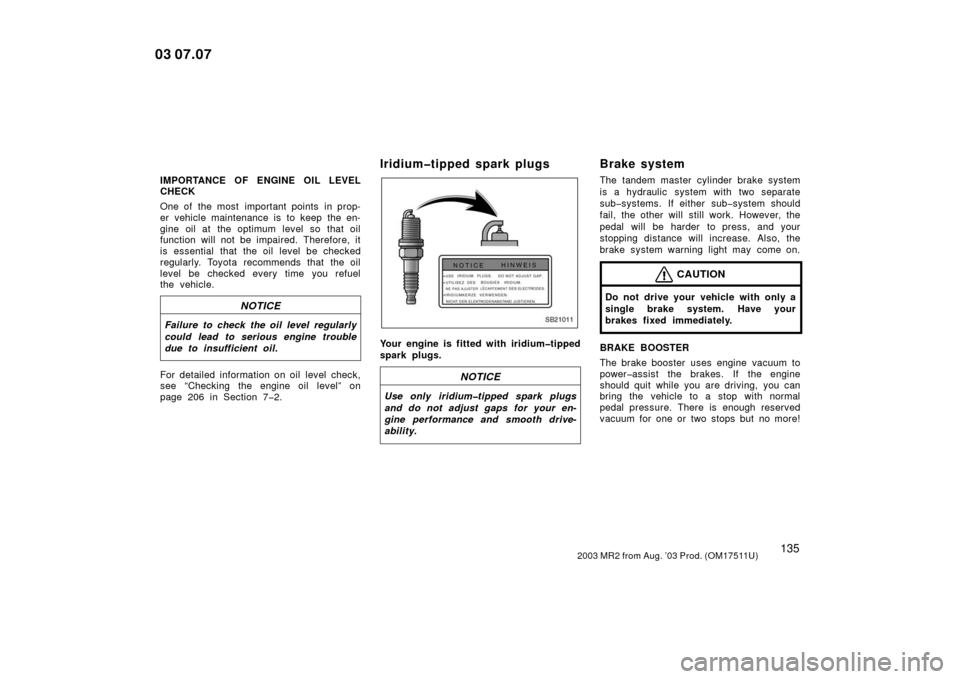Page 86 of 265
772003 MR2 from Aug. ’03 Prod. (OM17511U)
Service reminder indicators and warning buzzers
If the indicator or buzzer comes on...Do this.
(a)If parking brake is off, stop immediately and contact Toyota dealer.
(b)Fasten driver ’s seat belt.
(c)Fasten passenger ’s seat belt.
(d)Stop and check.
(e)Stop and check.
(f)Take vehicle to Toyota dealer.
(g)Low fuel level warning lightFill up tank. (See “Fuel gauge” on page 74 in this Section.)
(h)Take vehicle to Toyota dealer immediately. If the vehicle cannot be driven, contact your
Toyota dealer.
03 07.07
Page 87 of 265
782003 MR2 from Aug. ’03 Prod. (OM17511U)
If the indicator or buzzer comes on...Do this.
(i)Take vehicle to Toyota dealer.
(j)Close both the doors.
(k)Take vehicle to Toyota dealer immediately.
(l)Take vehicle to Toyota dealer.
(m)Key reminder buzzerRemove key.
(n)Light reminder buzzerTurn off lights.
(o)Warning function of the
sequential manual transmissionSee “Sequential manual transmission” on page 85 in Section 1�6.
03 07.07
Page 91 of 265

822003 MR2 from Aug. ’03 Prod. (OM17511U)
(l) Power Steering System WarningLight
This light warns that there is a problem
in your power steering system.
If the light comes on while you are driv-
ing, have your vehicle checked by your
Toyota dealer as soon as possible.
(m) Key Reminder Buzzer
This buzzer reminds you to remove the
key when you open the driver ’s door with
the ignition key in the “ACC” or “LOCK”
position.
(n) Light reminder buzzer
The buzzer will sound if the headlight
switch is left on and the driver’s door is
opened with the key removed from the
ignition switch.
(o) Warning function of the Sequential Manual Transmission (sequential
manual transmission only)
When driving, if any incorrect operation
that may cause damage to this system is
performed or if the gear is not shifted as
desired by the driver, the warning buzzer
will sound and the gear position indicator
will flash to warn the driver in some
cases. For details, see “(k) Warning
functions” on page 94 in Section 1�6. CHECKING SERVICE REMINDER
INDICATORS (except the low fuel level
warning light)
1. Apply the parking brake.
2. Open either side door. The open door warning light should
come
on.
3. Close the door. The open door warning light should go
off.
4. Turn the ignition key to “ON”, but do not start the engine.
All the service reminder indicators ex-
cept the open door warning light should
come on. The “ABS” and power steer-
ing system warning lights go off after
a few seconds. The SRS warning light
goes off after about 6 seconds.
If any service reminder indicator or warn-
ing buzzer does not function as described
above, have it checked by your Toyota
dealer as soon as possible.
03 07.07
Page 93 of 265

842003 MR2 from Aug. ’03 Prod. (OM17511U)
SB16007
“START”—Starter motor on. The key
will return to the “ON” position when
released.
For starting tips, see page 153 in Section
3.
“ON”—Engine on and all accessories
on.
This is the normal driving position.
“ACC”—Accessories such as the radio
operate, but the engine is off.
If you leave the key in the “ACC” or
“LOCK” position and open the driver’s
door, a buzzer will remind you to remove
the key.“LOCK”—Engine is off and the steering
wheel is locked. The key can be re-
moved only at this position.
You must push in the key to turn it from
“ACC” to the “LOCK” position.
Once you remove the key, the engine im-
mobilizer system is automatically set. (See
“Engine immobilizer system” on page 10
in Section 1�2.)
When starting the engine, the key may
seem stuck at the “LOCK” position. To
free it, first be sure the key is pushed all
the way in, and then rock the steering
wheel slightly while turning the key gently.
CAUTION
Never remove the key when the ve-
hicle is moving, as this will lock the
steering wheel and result in loss of
steering control.
NOTICE
Do not leave the key in the “ON”
position if the engine is not running.
The battery will discharge and the
ignition could be damaged.
03 07.07
Ignition switch with steering
lock
Page 98 of 265

892003 MR2 from Aug. ’03 Prod. (OM17511U)
CAUTION
�Be careful when accelerating, up-
shifting, downshifting or braking on
a slippery surface. Sudden accelera-
tion or engine braking could cause
the vehicle to spin or skid.
�To drive down a long or steep hill,
reduce your speed and downshift.
Remember, if you ride the brakes
excessively, they may overheat and
fail.
�Do not place the selector lever in
the “N” position while driving.
Otherwise the engine brake may not
work, and you may get involved in
an unexpected accident.
�Do not apply the parking brake
while driving. Otherwise, it could
cause a skid and you may get in-
volved in an unexpected accident.
NOTICE
�The system will not allow shifting
up or down to a gear that would
cause engine over�revving or un-
der�revving. When engine over�rev-
ving occurs, a warning buzzer
(short pulse sound) will sound. In
either case, the demand will be can-
celled.
� If frequently driving at low speed
using a high gear position, a warn-
ing buzzer (long pulse sound) will
sound. Such driving will cause the
reduction of clutch life.
� Frequent downshifting (more than 3
positions continuously) causes the
reduction of transmission life.
� Do not drive with your foot on the
brake pedal. Otherwise, it will cause
the “Sequential manual
transmission” warning light to come
on.
(e) Starting off
1. Start the engine as instructed in “How to start the engine” on page 154 in
Section 3. 2. With your foot holding down the brake
pedal, shift the selector lever to the “S”
position properly. When the selector le-
ver is shifted to “S” position, the gear
will be shifted to 1st. On a slippery
surface, it is possible to start off with
the gear in 2nd. To start off with the
gear in 2nd, shift the selector lever
from “N” to “S” position, then operate
the lever to “+” direction. The gear will
be shifted to 2nd. Before starting off,
always make sure that the gear is en-
gaged by the gear position indicator,
then depress the accelerator pedal.
If the gear cannot be engaged to 1st
when the selector lever is shifted from
the “N” to “S” position, the “N” indica-
tor will flash and a warning buzzer
(long pulse sound) will sound. In this
case, the system will re�try shifting or
the driver can operate the selector le-
ver to shift, as follows.
�The system will re�try shifting automat-
ically. This will take some time, noise
may be heard from the gears, and shift
shock may occur. However, they do not
indicate malfunction.
�The driver may shift the selector lever
to the “N” position once, then shift to
the “S” position.
03 07.07
Page 144 of 265

1352003 MR2 from Aug. ’03 Prod. (OM17511U)
IMPORTANCE OF ENGINE OIL LEVEL
CHECK
One of the most important points in prop-
er vehicle maintenance is to keep the en-
gine oil at the optimum level so that oil
function will not be impaired. Therefore, it
is essential that the oil level be checked
regularly. Toyota recommends that the oil
level be checked every time you refuel
the vehicle.
NOTICE
Failure to check the oil level regularly
could lead to serious engine trouble
due to insufficient oil.
For detailed information on oil level check,
see “Checking the engine oil level” on
page 206 in Section 7�2.
Iridium�tipped spark plugs
SB21011
Your engine is fitted with iridium�tipped
spark plugs.
NOTICE
Use only iridium�tipped spark plugs
and do not adjust gaps for your en-
gine performance and smooth drive-
ability.
Brake system
The tandem master cylinder brake system
is a hydraulic system with two separate
sub�systems. If either sub�system should
fail, the other will still work. However, the
pedal will be harder to press, and your
stopping distance will increase. Also, the
brake system warning light may come on.
CAUTION
Do not drive your vehicle with only a
single brake system. Have your
brakes fixed immediately.
BRAKE BOOSTER
The brake booster uses engine vacuum to
power�assist the brakes. If the engine
should quit while you are driving, you can
bring the vehicle to a stop with normal
pedal pressure. There is enough reserved
vacuum for one or two stops but no more!
03 07.07
Page 150 of 265
1412003 MR2 from Aug. ’03 Prod. (OM17511U)
This illustration indicates typical tire
symbols.1. Tire size— For details, see “Tire
size” on page 143.
2. DOT and Tire Identification Number (TIN)— For details, see
“DOT and Tire Identification Num-
ber (TIN)” on page 142.
3. Maximum cold tire inflation pressure— This means the pres-
sure to which a tire may be in-
flated. For recommended cold tire
inflation pressure, see “Tires” on
page 242.
4. Load limit at maximum cold tire inflation pressure— For details,
see “Checking and replacing tires”
on page 213.
5. Location of tread wear indica- tors— For details, see “Checking
and replacing tires” on page 213.
6. Turning indicator— Some
vehicles are equipped with
directional tires. For details, see
“Rotating tires” on page 216.
03 07.07
Tire information—
—Tire symbols
SB21020b
Page 151 of 265

1422003 MR2 from Aug. ’03 Prod. (OM17511U)
7. Uniform tire quality grading—For details, see “Uniform tire quali-
ty grading” that follows.
8. Tire ply composition and mate- rials— Plies mean a layer of rub-
ber�coated parallel cords. Cords
mean the strands forming the plies
in the tire.
9. “TUBELESS” or “TUBE TYPE”— A tubeless tire does not
have a tube inside the tire and air
is directly filled in the tire. A tube
type tire has a tube inside the tire
and the tube maintains the air
pressure.
10.Radial tires or bias�ply tires— A
radial tire has “RADIAL” on the
sidewall. The tire not marked with
“RADIAL” is a bias�ply tire.
11. Summer tire or all season tire— An all season tire has “M+S”
on the sidewall. The tire not
marked with “M+S” is a summer
tire. For details, see “Types of
tires” on page 152.
SB21022a
This illustration indicates typical DOT
and Tire Identification Number (TIN).
1. “DOT” symbol
2. Tire Identification Number (TIN)
3. Tire manufacturer ’s identification mark
4. Tire size code
5. Manufacturer ’s optional tire type code
6. Manufacturing week
7. Manufacturing year The “DOT” symbol certifies that the
tire conforms to applicable Federal
Motor Vehicle Safety Standards.
03 07.07
—DOT and Tire Identification
Number (TIN)